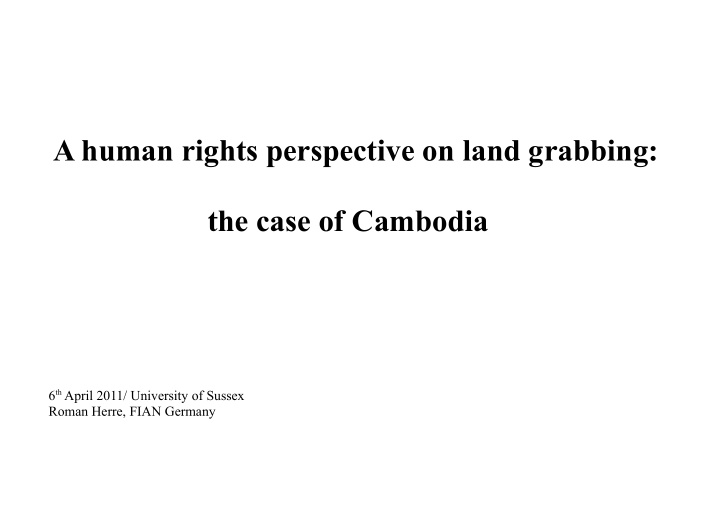



A human rights perspective on land grabbing: the case of Cambodia 6 th April 2011/ University of Sussex Roman Herre, FIAN Germany
Land grabbing: The case of Cambodia _____________________ Kampong Speu 'Degraded forests' for 20.000 ha sugar cane plantation
Land grabbing: The case of Cambodia _____________________ Bulldozers at work Clear defined rights of communities are ignored
Land grabbing: The case of Cambodia _____________________ Fences and military protects the new operations
Land grabbing: The case of Cambodia _____________________ People are evicted and lose access to land Community resistance
Land grabbing: The case of Cambodia _____________________ Concessions in northern Kampong Speu Only small 'survival corridors' for the rural population Map by LICADHO
Land grabbing: The case of Cambodia _____________________ Map by sithi.org (Cambodian Human Rights Portal) The national scramble for land Concessions and SEZ until mid-2009: More than 3 Mio. ha Total arable land 5,5 Mio ha
Land grabbing: The case of Cambodia _____________________
Land grabbing: The case of Cambodia _____________________ Complex land grab dynamics 1. Mix of actors : national elites (e.g. senators) and foreign companies; 2. Strong trade incentives for sugar cane production: development initiative of EU (Everything But Arms) part of the business model; 3. National land policy (support by int. development cooperation like GIZ): • Process of land titling (20% of the 'beneficiaries' have lost land); • Exclusion of 'contested land'; • Weakening of existing rights (e.g. possession rights); 4. International money (investment funds) behind the active companies;
Land grabbing: The case of Cambodia _____________________ The case of DWS (Deutsche Bank Group): • KSL acquired 20.000 ha land for sugar cane production in Koh Kong Province; • 450 families lost access to land; • in 2008 DWS was 5 th largest shareholder of the Thai sugar company KSL; Company ● Country ● Funds ● Total investment (€ mln) Agroton Public Ukraine D, F 2.6 ● ● ● ● ● Australian Agricultural Co (AAC) ● Australia ● D, F , G ● 14.2 ● BrasilArgo ● Brazil ● D, F , G ● 12.5 ● Bunge ● United States ● A, B, C, D, E, F , H ● 90.7 China Forestry Holdings China F 2.0 ● ● ● ● ● Cresud ● Argentina ● D, F , G ● 17.8 ● Cosan ● Brazil ● A, H, G ● 9.7 ● Khon Kaen Sugar Industry company ● Thailand ● D, F , G ● 10.9 KTG Agrar Germany D, F 0.6 ● ● ● ● ● Magindustries ● Canada ● D, F , G ● 6.3 ● MCB Argricole Holdings ● Ukraine ● D, F , G ● 0.6 ● Noble Group ● China ● D,G ● 15.3 Olam International Ltd Singapore C, D, F , G 21.2 ● ● ● ● ● Razgulay Group ● Russia ● D, F ● 10.6 ● São Martinho SA ● Brazil ● D, F , G ● 21.4 ● Sintal Agriculture Plc ● Ukraine ● D, F , G ● 3.5 Brazil D, F , G 45.7 ● SLC Agricola SA ● ● ● ● Syngenta AG ● Switzerland ● A, H, D, G ● 61.5 ● Union Agriculture Group ● Uruguay ● D ● 2.2 ● Wilmar International ● Singapore ● B ● 0.2 • Overall they invested at least 4,5 billion € in companies that acquire land;
Land grabbing: The case of Cambodia _____________________ Legitimative narrative (investors/ states): „ With the road came the bulldozers“ • Marginal lands, degraded (=useless) forests (Peasant in Kampong Speu) • Jobs, jobs, jobs… • Infrastructure • Economic development for the benefit of all „Today, when they talk about develpoment, we have fear“ Reality check: (Villager in Kampot) • Productive land, land highly relevant for local food security; • No jobs: ◦ Small number of workers needed (industrial farming); ◦ Very low wages; ◦ Seasonal/ precarious work; • Infrastructure not for local needs ◦ Export infrastructure (SEZs, ports, national roads...) • Further marginalization of rural communities;
Land grabbing: The case of Cambodia _____________________ Human rights perspective • National law: o Concessions are highly contestable under national law (e.g. over half the concessions are above the legal size of 10.000 ha, World Bank 2005); o Does not adequately cover rights to land of some local communities ('injust laws' form RtF perspective) ; • The right to food perspective: o Immediate and most concrete violations: Forced eviction; Loss of access to land (rice fields, forests, water, fishing grounds);
Land grabbing: The case of Cambodia _____________________ Escalating Land Conflicts Land related human rights abuses in 13 provinces/ municipalities (number of families involved) Source: LICADHO (2009) The Myth of Development 16462 15000 12299 10000 10250 Some 250.000 people have been involved in 8847 land conflicts in these provinces 5000 3274 2626 0 2003 2004 2005 2006 2007 2008
Land grabbing: The case of Cambodia _____________________ o Structural aspects: Accelerated land concentration ('negative agrarian reform'); Instead of empowering the peasants/ rural communities they are further marginalized; Who produces? Who benefits from production? The ability of the rural population to feed themselves is strongly reduced; The ability of states to provide access to land for a growing rural population as part of their state obligation becomes very limited;
Land grabbing: The case of Cambodia _____________________ In no case may a people be deprived of its own means of subsistence. (Article 1 of both International Covenants on Economic, Social and Cultural Rights and on Civil and Political Rights) Thank you www.fian.de / www.fian.org r.herre@fian.de
Recommend
More recommend